All products featured are independently chosen by us. However, SoundGuys may receive a commission on orders placed through its retail links. See our ethics statement.
The Fluance Ai40 review: Loud sound, innocuous design
Published onJune 7, 2018
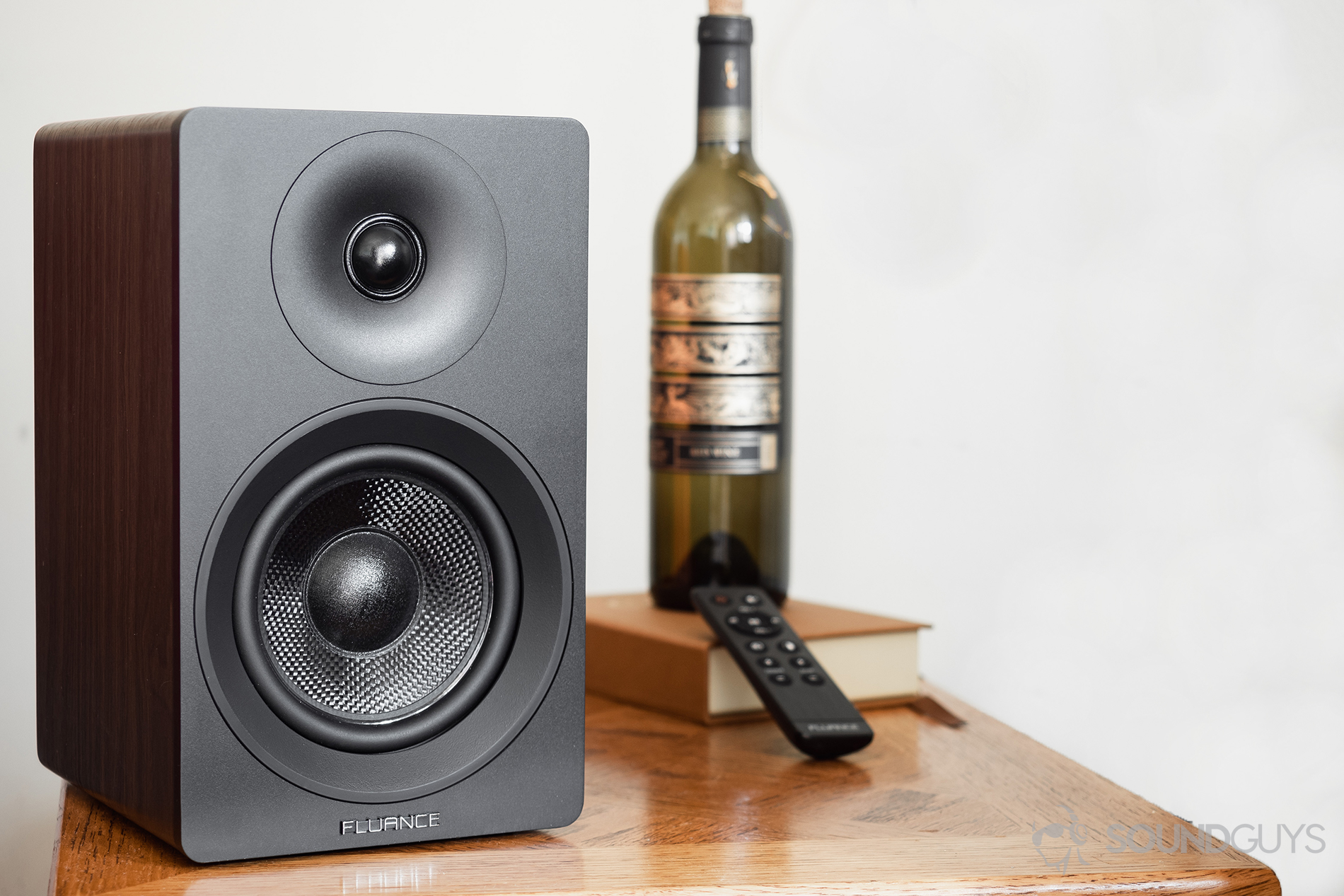
If you had asked me in May what Fluance was, I might have guessed it was the noise that members of society’s upper echelon make when they sneeze. A few weeks later, however, and I know better; Fluance is a Canadian-based audio company that produces home audio music systems and turntables. Though they have plenty of products, we’re here to look at the Ai40 bookshelf speakers.
Who are the Fluance Ai40 for?

The Fluance Ai40 is for listeners who are are beginning their home theater journey. Whether you’ve already started arranging a surround sound setup or this is your first foray, the Fluance Ai40 are a reasonably priced pair of speakers that complement any living space. Additionally, these don’t require input and channel mapping. Rather, they’re plug-and-go speakers that connect via RCA or Bluetooth aptX; with these, you’ll be ready to relax and listen in no time.
“I’m not good with electronics. How long does it take to set up?”
As someone who was initially intimidated by the prospect of setting up bookshelf speakers, I can earnestly say that the Ai40 are easy to figure out. The back of each speaker houses a pair of binding posts that need to be loosened in order to connect the 18-gauge speaker wire. When doing so, make sure that the same wire is connected to the same colored binding post.
Setup is amatter of loosening and tightening the binding posts. Well, that and choosing between connecting via Bluetooth or RCA.
Once that step is complete, plug in the included power adapter. From there, you can opt for RCA or Bluetooth connectivity. Unless you’re connecting to a record player or additional piece of home theater hardware, Bluetooth is the most obvious choice. Since the speakers are aptX-compatible, you’ll be able to achieve CD-like quality with 16-bith/44.1kHz audio at 352kbps.
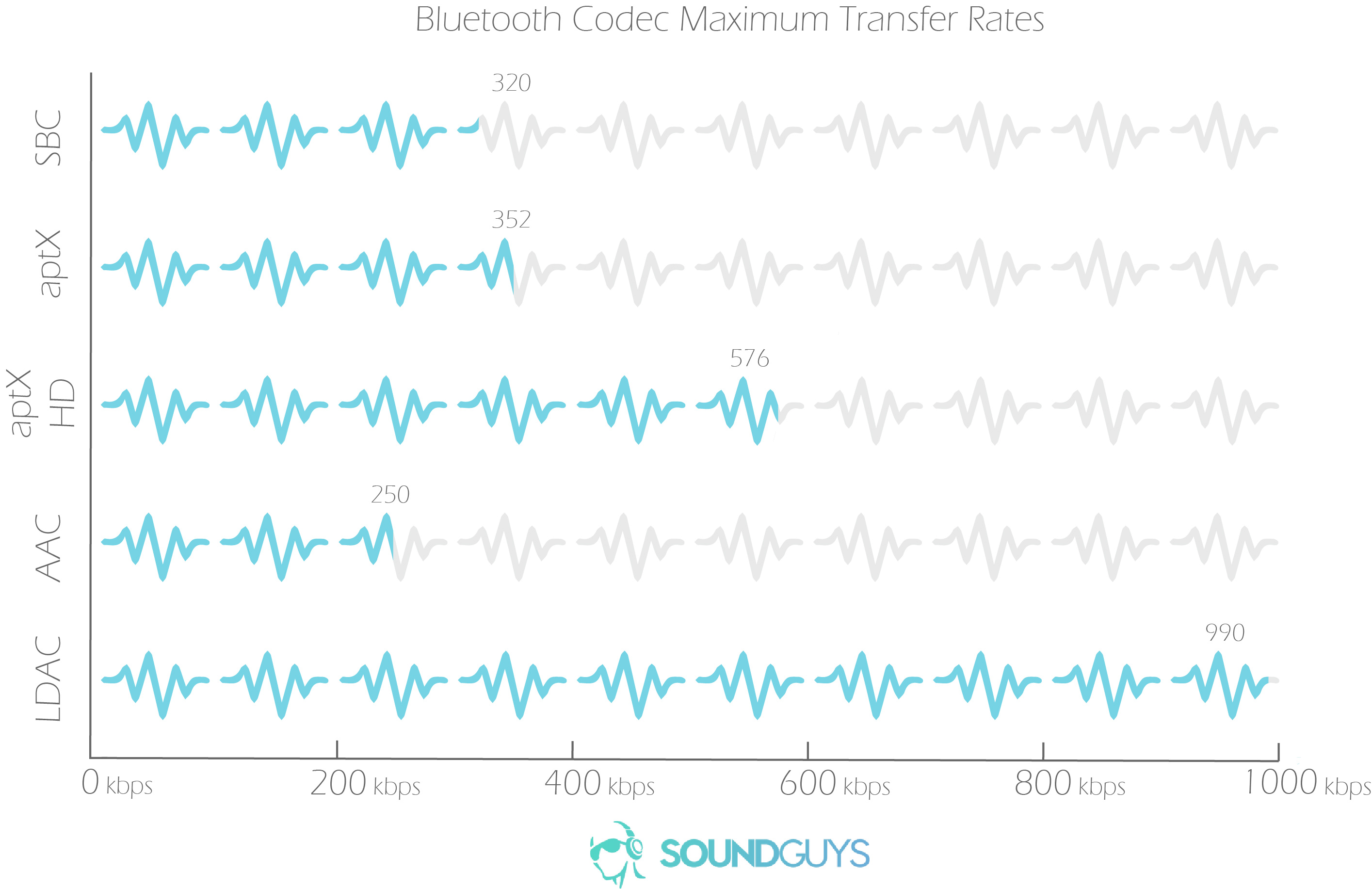
How does Bluetooth pairing work?
Just like the initial setup, Bluetooth pairing is simple.
- Depress the control knob on the right (active) speaker until the adjacent LED indicator flashes blue.
- Enter Bluetooth “search mode” on your source device and select “Fluance Ai40.” If you’re having trouble, turn off the last Bluetooth accessory that your source device connected to.
- If you’re unable to pair the devices. Press and hold the play/pause button on the remote for three seconds, or press and hold the pairing reset button on the back of the active speaker.
- After the initial pairing process, your device with auto-connect to the Fluance Ai40.
What’s included
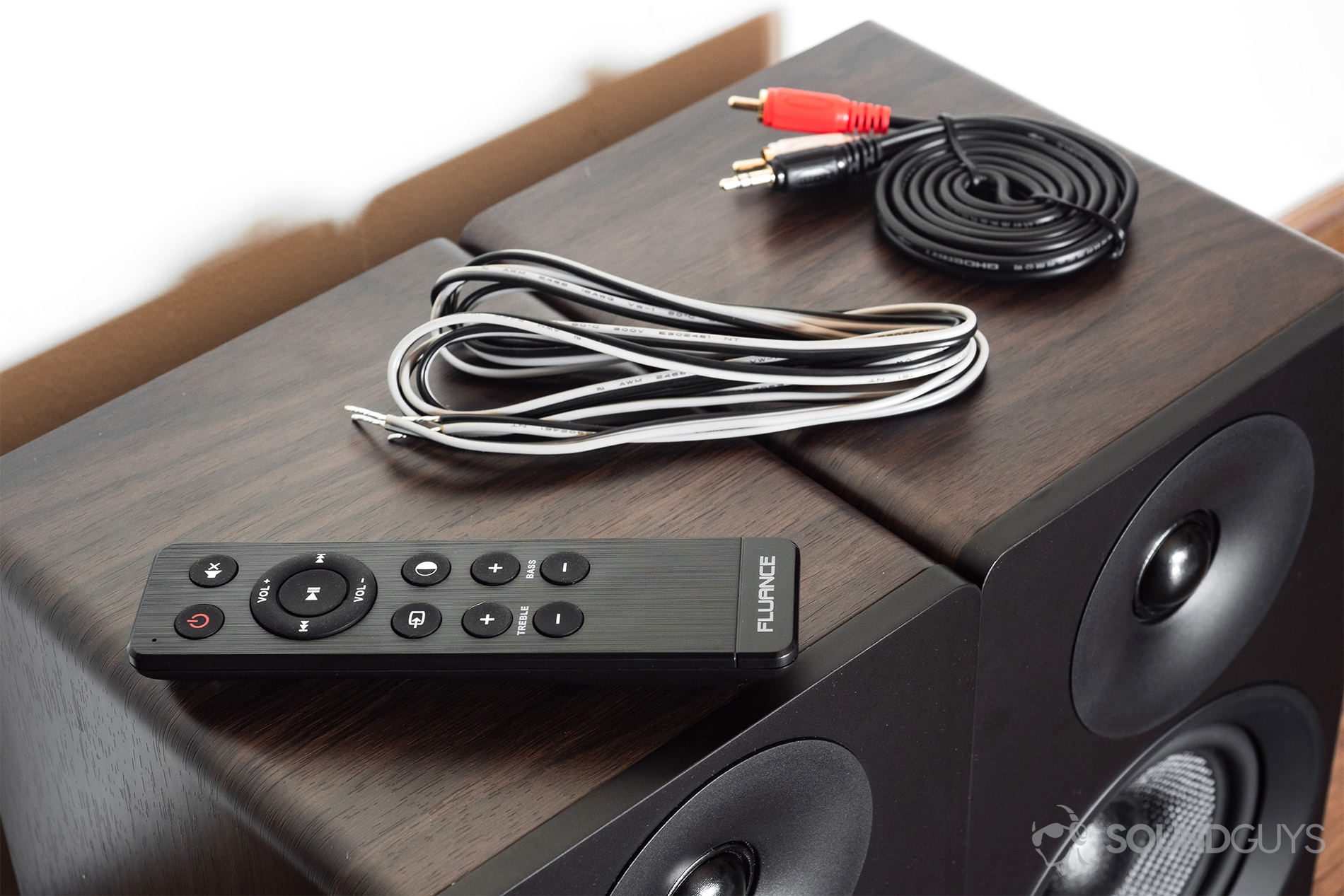
Inside the Ai40’s mammoth packaging are the speakers; a remote control; two AAA batteries; a 100-240V power adapter; an eight-foot, an 18-gauge speaker wire; a 3-foot, 3.5mm aux to RCA cable; and paperwork. The included quick start guide is well-written and easy to follow. If you tend to struggle with technology but are determined to get the Ai40, make sure to refer back to the manual. It will save you plenty of time.
Build and design
The speakers are available in three finishes: walnut, bamboo, and a black-stained finish. Each speaker houses a 1-inch, ferrofluid tweeter that’s covered by a silk dome beneath which is a 5-inch, woven glass fiber composite driver that’s surrounded by butyl rubber. The enclosure is classified as an acoustic suspension design, which means that the driver is mounted within a sealed enclosure.
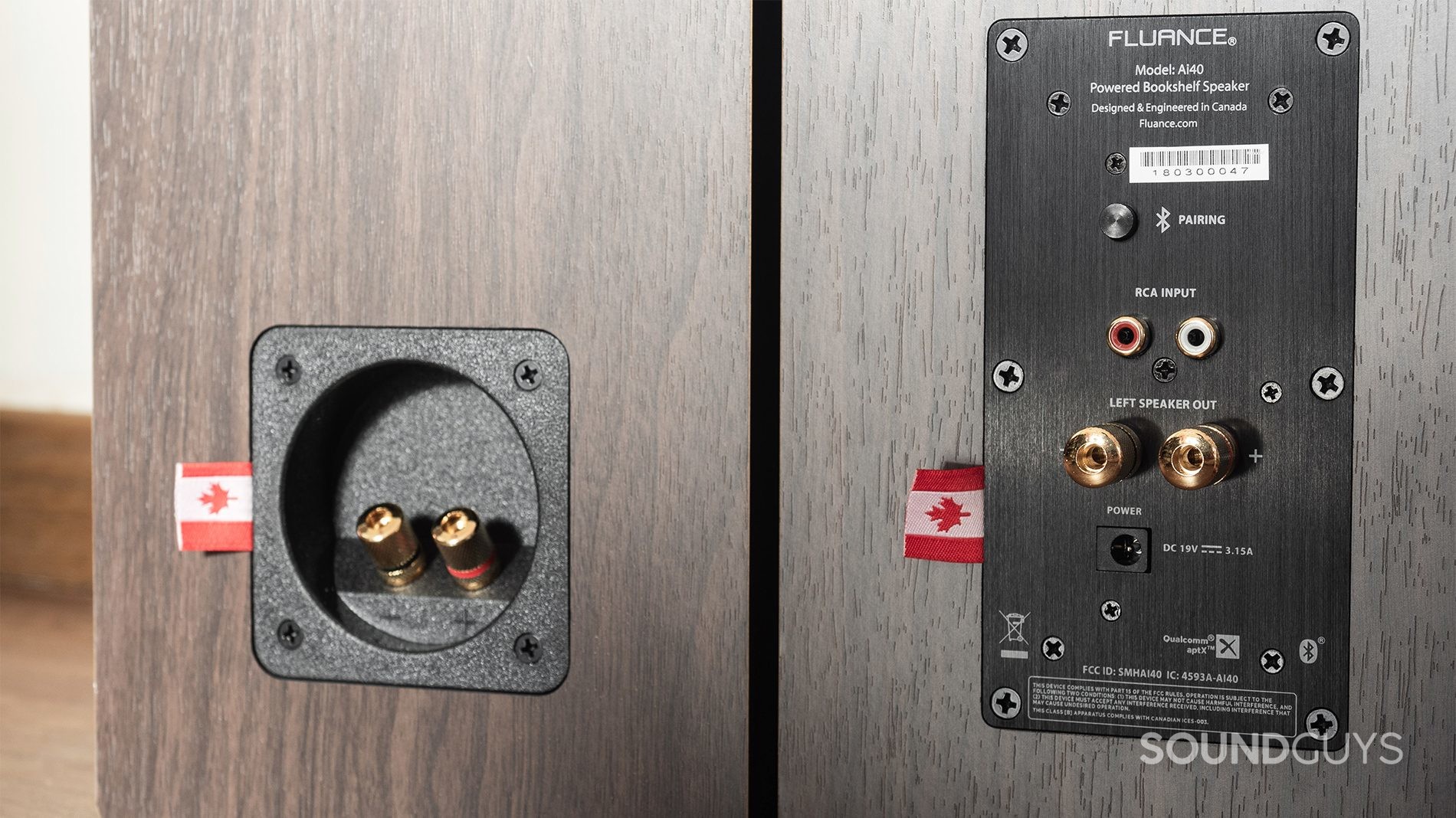
Aside from being differentiated by “left” and “right” speaker, Fluance notes that the right speaker is the active one, which relays a signal to the passive left speaker. Both units display the Fluance name, and the active speaker has a multi-function knob to control pairing, source alternating, and volume. On the lower left corner of the same speaker, you’ll find the infrared receiver for the Fluance remote.
The acoustic suspension design reduces low-end distortion that conventional, stiff motor speakers are prone to producing.
The backside of each speaker has metal binding posts that can be loosened and tightened as needed. As you might expect, the active speaker is outfitted with the bulk of the inputs—including the RCA inputs and Bluetooth reset button. The rest of the speaker is plain; yet, they manage to look sophisticated with the walnut finish that wraps around the paneling.
While wood lovers may bemoan the fact that the speakers aren’t made totally of walnut, it’s for the best. Walnut is very heavy, and would make both speakers very unwieldy. If your shelves aren’t the strongest, they’ll appreciate the lighter choice of MDF cabinets that these speakers are housed in.
What can I control with the remote?
Well, you can adjust quite a few things. Naturally, the remote has the obligatory power and playback toggles, volume adjustment, and mute button. But, as every 2 a.m. infomercial likes to remind you, “there’s more!” Also, you can switch sources and adjust the active speaker’s LED brightness.
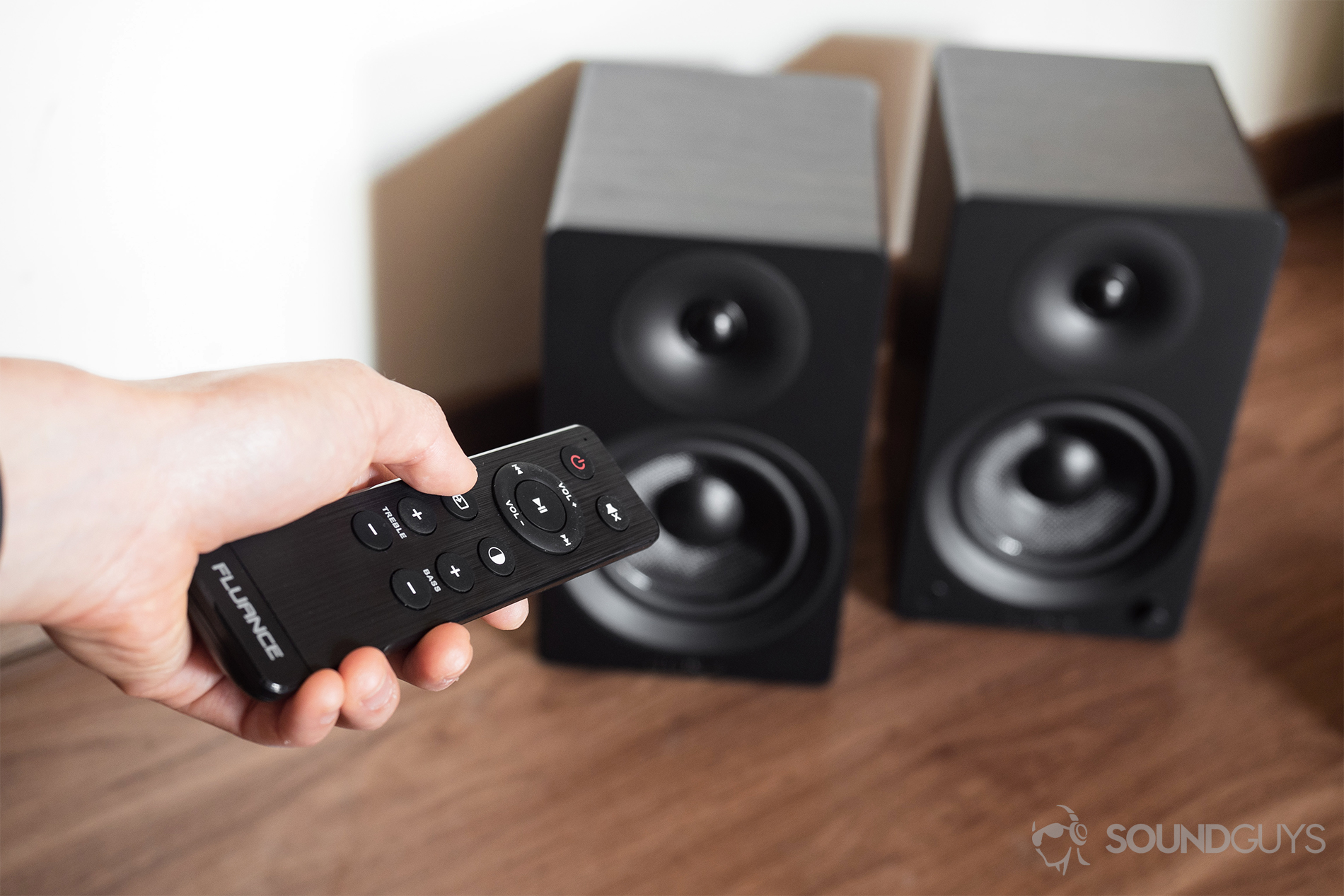
Below those buttons are my favorite toggles which control treble and bass emphasis. The only hiccup worth discussing in regards to the remote is that it’s slow to relay commands to the Ai40. By slow, I mean that there’s a one-second delay but in today’s day and age, that’s a glacial pace.
Connectivity
Fluance gives you a few options when it comes to how you want to use these bookshelf speakers. After you’ve connected the active speaker to the passive one, you can use the included RCA cable to connect to a phone, or you can use a dual RCA cable to connect to other home theater devices. If you’re opting for Bluetooth, just pair the speakers to your phone and your ready to go.
The option to connect via RCA cable or Bluetooth makes the Fluance Ai40 a versatile set of speakers. Though, most home theater setups require a two-way RCA speaker, which must be purchased separately.
There aren’t any flashy features included with the Ai40, but you do get aptX codec support, which reproduces CD-like quality. Additionally, multi-point connectivity is available and easy to operate. In order to alternate between one source device to another, press and hold the control knob on the active Fluance Ai40 speaker, or the source button on the remote control.
“What do all of the LED flashes mean?”
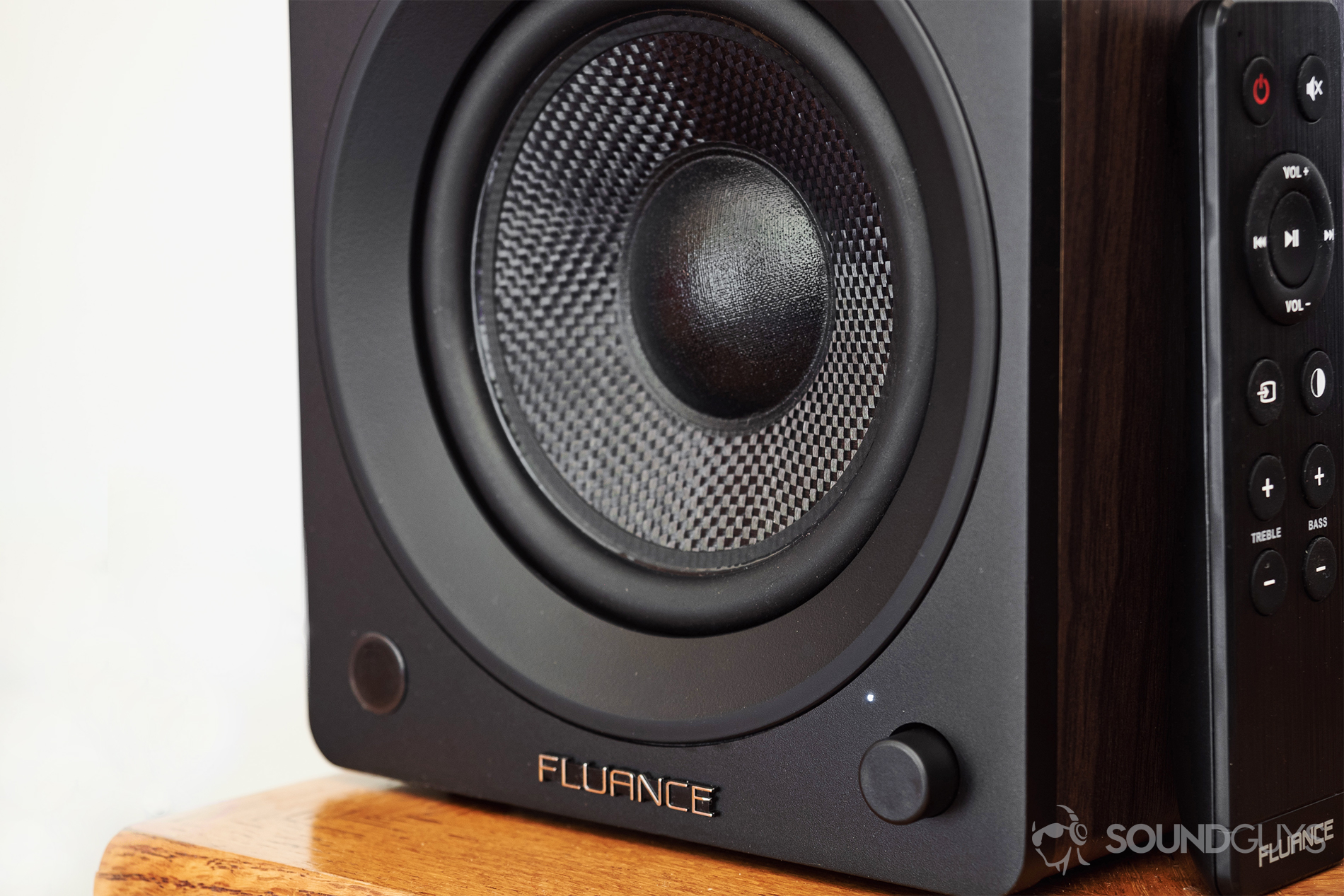
Seeing the LED flash at you without knowing what it means can be concerning or, at the very least, annoying. And, no, experience with Morse code won’t help you here. Fortunately, we have a list from the Fluance Ai40 manual to help you out.
- Blue (solid): Bluetooth is paired
- Blue (flashing): Bluetooth pairing mode
- Yellow (solid): RCA
- Red (solid): Standby mode
- Red (flashing): Mute
- Red (double-flash): Bass or treble set to +/-5
- Blue/Yellow (double-flash): Bass or treble set to 0
What about wired use?
A necessary evil of the acoustic suspension design is lower efficiency due to the increased force necessary to move the speakers. Consequently, we recommend using these with a receiver and decently fat cables (lower impedance) if you want to squeeze the most out of the Fluance Ai40. It’s not really necessary to obsess over the right gauge of wire and power requirements, but the more power you can get to these units: the more likely you’ll be able to get the volume you want. If you find that volume is a problem with your receiver, definitely consider using the Bluetooth function instead if you can.
Sound quality
These sound great and provide a fairly neutral frequency response, but if you—like most of us—favor emphasized bass and prominent treble, you can easily adjust that via the remote. After just over a week of testing, I was pleased not only with how the Ai40 sound by default but also how taking a few minutes to adjust the EQ improves the sound.
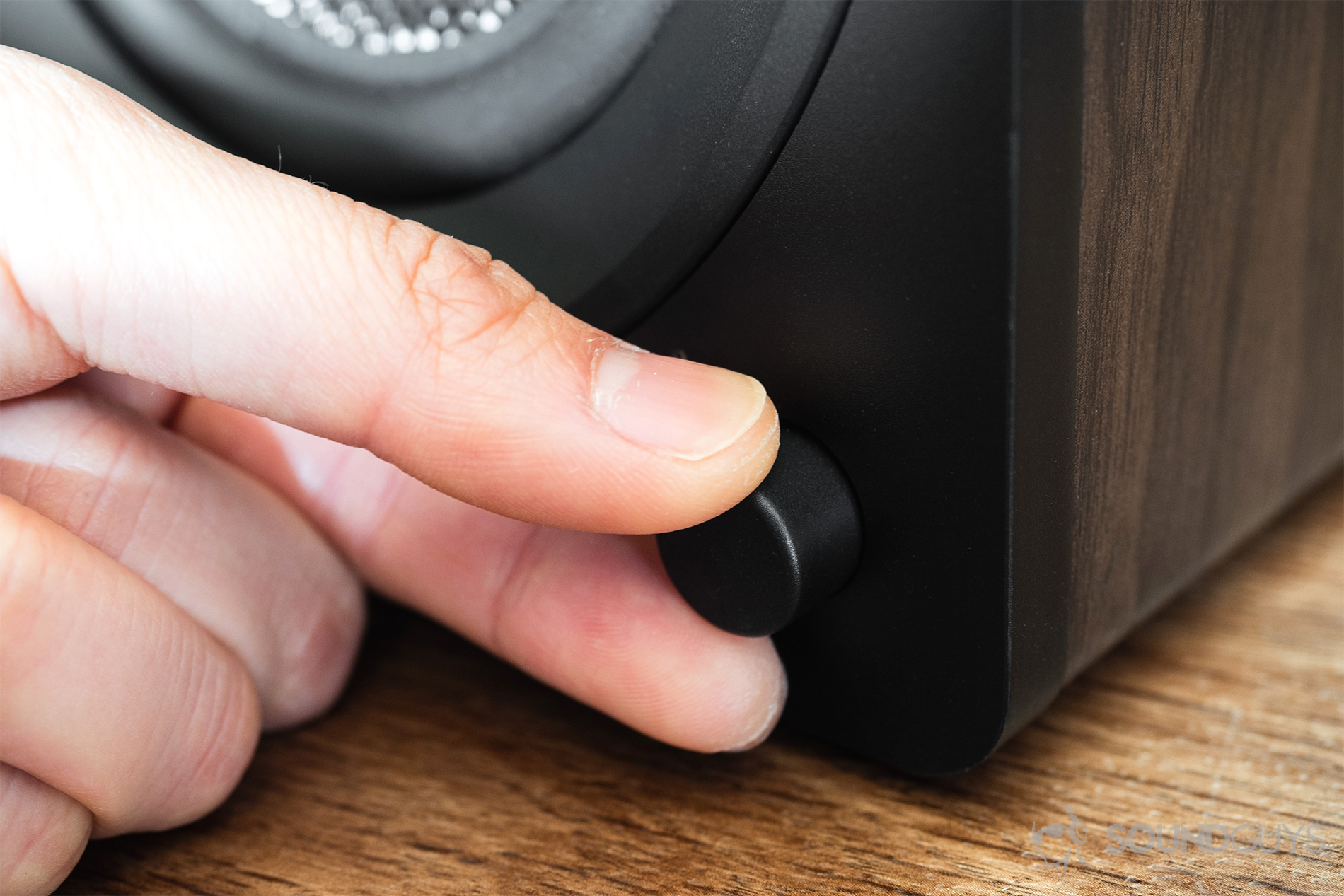
At 64BA, I found the default bass setting to be slightly lacking, causing me to increase the low-end to +2, 0 being the default. Additionally, the treble is easily masked by midrange frequencies, so I increased that to +1. Note: you can decrease the bass or treble all the way down to -5, but I found doing so wasn’t necessary unless you max-out the volume to a recorded 94.2dBA.
Default sound and suggested EQ-ing
To give an example of why these EQ settings are effective, let’s take Super America by the Bad Bad Hats. While I was sitting on the couch just 3 meters away from the Fluance Ai40, the sound level meter reported a relative loudness of 52dBA. Now, with the default settings—bass and treble both set to 0—the speakers sound really good, but you can easily make to make them sound great… perhaps even exceptional.
Lows
The song’s intro is backed by a basic drum rhythm that consists of the bass and snare drums. However, with the above settings and positioning in place, the bass drum is hardly comprehensible. What’s more because of this under emphasis, the snare drum sounds exaggerated. Once Kerry Alexander begins singing and the other guitars join in, the low-end becomes even more difficult to hear. Therefore, I’d encourage most users to increase the bass to +3 or +4.
Mids and highs
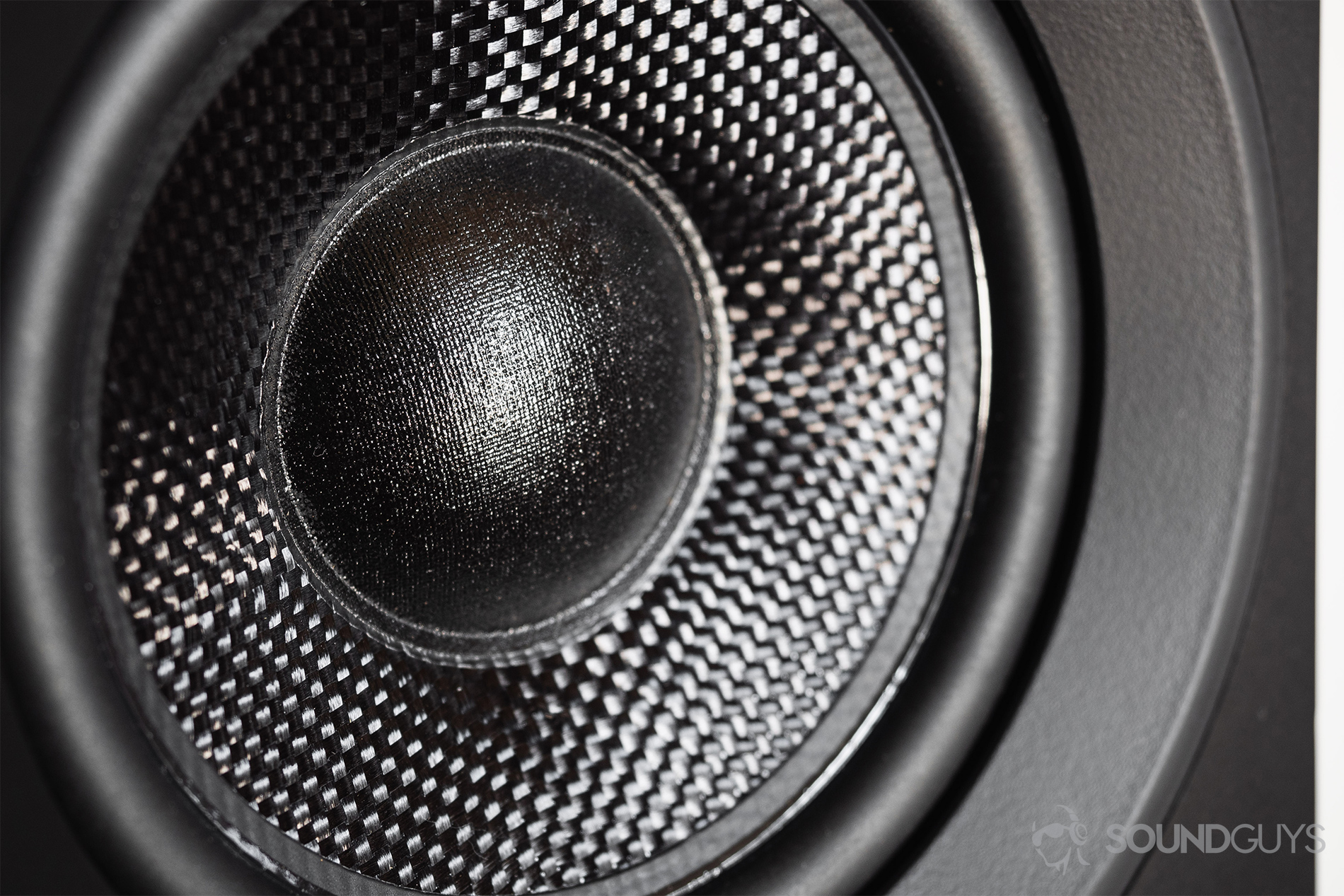
Alexander’s voice is clear and the Ab/G#-C#/Db-Bb chord progression doesn’t distract from her vocals at all. In fact, it’s hard to hear the guitarists above her voice. This becomes particularly apparent during the bridge that follows the first chorus (1:20). Here, the guitar solo—a three-time repetition of Ab/G#-Bb—sounds awfully quiet, and there isn’t even another instrument to eat up auditory bandwidth.
In this instance, the treble just sounds that under emphasized. So, when the volume is this low, I increase the treble to +1. Yes, this is the same as when the loudness is increased, but I found that upping the treble to +2 or more amplifies sibilance with cymbals and tambourines.
Should you buy the Fluance Ai40?
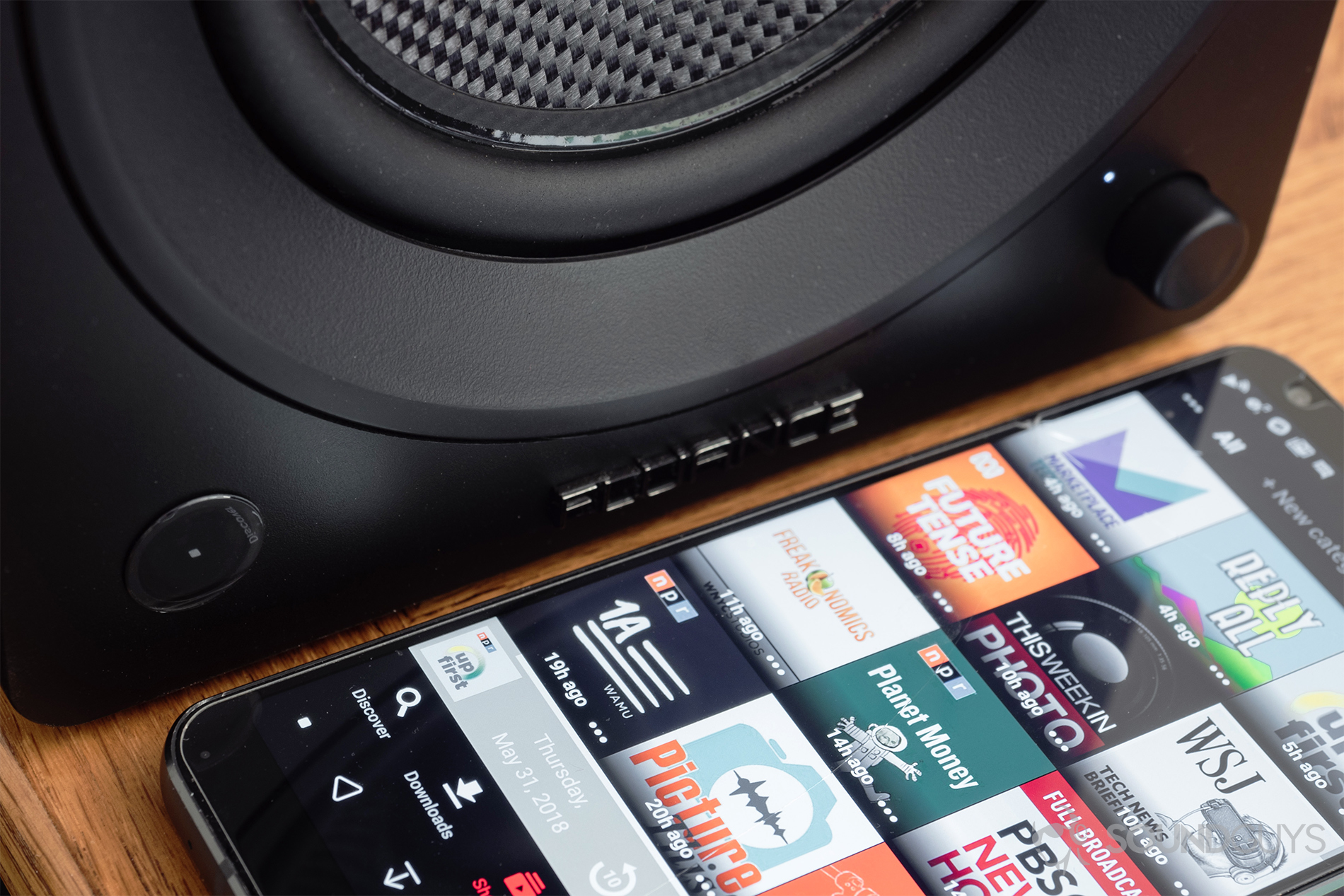
Yes. They originally retailed for $299 and can now be had for $199. At the original price, I’d be hesitant to give these such an enthusiastic recommendation, but for a pair of sub-$200 speakers, these are a no-brainer for home audio enthusiasts. Though it’s disappointing that aptX HD and LDAC aren’t supported, aptX should be sufficient for most listeners.
The Ai40 are a simple-to-setup, versatile pair of bookshelf speakers that include a two-year warranty.
If the idea of customizing the EQ via the remote’s treble and bass adjustment toggles is concerning, just know that the above adjustments should serve as a pleasing starting place and that you can always tweak from there, or completely revert the settings. What’s more, hardware setup doesn’t get much simpler than it is with the Ai40. From the home audio beginning to the ardent enthusiast, the Ai40 are a solid fit.